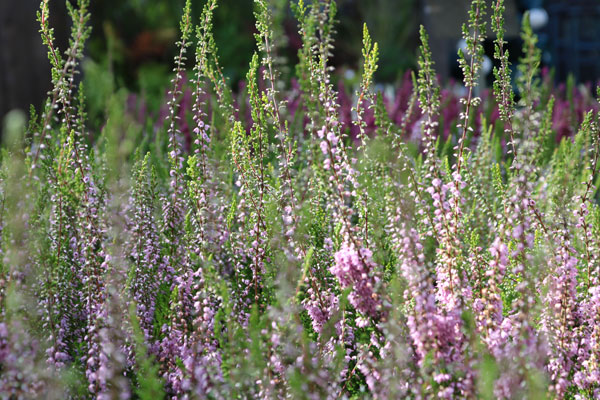Ground Cover

“Ground covers” are simply low growing plants that cover the ground. They are perfect plants to create the look of a living carpet, or stabilize a bank and prevent soil erosion. But the best thing about them is how great they look in the garden.
Once established these plants can cover the soil surface like a protective barrier, preventing weeds, and retaining soil moisture. They also are excellent at spreading out and establishing themselves. Many self-propagate when branches nodes contact the soil, roots form and the “carpet” grows dense and lush.
Planting
These plants by nature have a spreading habit, so need to be planted a good distance apart. It’s good to allow them at least 0.5m2 of space for themselves. Vigorous plants, such as cotoneaster and aegopodium, can spread quickly and should be planted 1m2 apart. Make sure to stagger the plants when planting, this is to make sure you don’t end up with a “grid” look.
Prepare the soil by removing any large rocks and apply some amendments, such as compost, well-rotted manure, bone meal or sea soil. Or if you have poor soil, consider planting a ground cover that can tolerate poor soils, such as houttynia or thyme.
Care & Feeding
A well-chosen ground cover should be virtually maintenance free once established. But until that happens, keep newly planted areas well-watered and weed free. Also, an annual application of all-purpose fertilizer (in the case of evergreen ground covers a Tree, Shrub and Hedge fertilizer is also good to consider) or any other organic soil amendments.
Click here to download a printable PDF.
RELIABLE GROUND COVERS FOR THE SHADE
Bugleherb (Ajuga reptans)is a low growing, fast spreading, herbaceous perennial, with blue candle-like flowers. There are several varieties available with green, bronze, variegated or tri-coloured foliage. A low maintenance easy to grow plant.
Bunchberry (Cornus canadensis) is a fast spreading, deciduous perennial with dainty spring dogwood-style flowers. These are followed by red berries and red-orange foliage in the fall. It is a bit particular but will grow happily if planted in a “woodland setting” of moist rich acid soil in shade or part-shade.
Wintergreen (Gaultheria procumbens) has dark green glossy evergreen leaves. White bell-shaped flowers appear in the summer and large, bright, red, edible berries set on bronze coloured foliage in the fall. Be sure to give it slightly acidic, moist soil.
Salal (Gaultheria shallon) has bright green, evergreen leaves, with white or pink bell-shaped flowers. Edible black berries appear in the fall. Plant it in sun or shade, it’s is very good on low nutrient soils.
Japanese Spurge (Pachysandra terminalis) is a fast-growing evergreen with light green branches, and very uniform in height. The spring flowers are creamy white “candles,” but are fairly insignificant. The real attraction is the bright foliage, which comes in both green or variegated form.
Lingonberry (Vaccinium vitis-idaea) is a slow growing evergreen with dark glossy leaves and reddish new growth. It spreads well by underground runners and has white or pink flowers followed by edible, but slightly sour, red berries. Plant it in moist, acidic soil.
Sweet Woodruff (Galium odoratum) is a creeping, mat-forming perennial with small flowers in spring. Foliage is sweetly fragrant. Plant it in a well-drained, acidic soil. Drought tolerant once established.
RELIABLE GROUND COVERS FOR THE SUN
Kinnikinnick (Arctostaphylos uva-ursi) is an evergreen with small glossy leaves that turn bronze in winter. With tiny, pendulous, pale-pink spring flowers that are followed by red berries in fall. This is a very effective plant on slopes and walls.
Heather (Calluna vulgaris) is a familiar evergreen to most, that is available in many varieties. It prefers moist, peaty, sandy, acidic, well-drained soil. These are great plants for nutrient poor soils. Shear after blooming to encourage low shrubby growth.
Cotoneaster is a genus of plants that have many attractive ground covers in both evergreen and deciduous. They are characterized by having green glossy leaves, with small white flowers that are followed by bright red berries in the fall/winter. A great choice for growing on slopes and in poor but moist soil.
Chameleon plant (Houttuynia cordata) is a fast-spreading herbaceous perennial, that can be slightly aggressive (so be mindful where you plant it). However, you might forgive it when you see the red, white and green leaves with small white flowers. Plant it in full sun to really benefit from the leaf variegation. In part-shade the leaves have a tendency to revert to green.
Junipers (Juniperus spp.) are coniferous evergreen shrub with long arching branches. There are many species and varieties available so be sure to read the tag for eventual height.
Thyme (Thymus spp.) are a group of evergreen ground hugging perennial herbs that are covered in pink/purple summer flowers. Walking on thyme releases its fresh scent, so it’s a great option for higher traffic areas. It prefers dry, exposed garden sites.
Creeping Phlox (Phlox subulata) is a low-growing, mat-forming flowering perennial, excellent for rock gardens and stone walls. Enjoys full sun, and rich, moist soil.
Lithodora is a small genus flowering perennials. Excellent for pathways and borders, as well as window boxes or containers. Tiny blue, star-shaped flowers from late spring to mid- or late summer. Plant it in a dry, acidic soil.
Iberis is a mounding and spreading perennial. Bursting with white blooms in spring. Drought and salt tolerant once established. Enjoys full sun and a variety of soil conditions.
